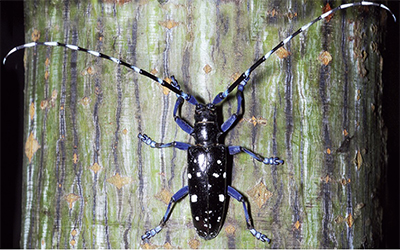Genomic tools to combat the spread of the invasive Asian longhorned beetle

The Asian longhorned beetle, Anoplophora glabripennis, also known as the starry sky beetle, is native to eastern Asia but has successfully invaded North America and Europe where it infests maple, birch, willow, elm, and poplar trees. Published in the journal Genome Biology, an international team of scientists report on the sequencing, annotation, and comparative exploration of this beetle’s genome in an effort to develop novel tools to combat its spread and better understand the biology of invasive wood-boring pests. The project involved scientists from more than 30 research institutions worldwide, including from the SIB Swiss Institute of Bioinformatics and the University of Geneva (UNIGE). The results begin to help unravel the complex genetic and genomic basis for the invasiveness of the Asian longhorned beetle and the evolutionary success of how beetles exploit plants.
The Swiss Federal Office for the Environment (FOEN) lists more than 100 invasive species already posing threats in Switzerland, including the Asian longhorned beetle and other insects such as the box tree moth, the harlequin ladybird, the Asian tiger mosquito, and the Ambrosia and Colorado potato beetles. The Swiss Federal Institute for Forest, Snow and Landscape Research (WSL) considers Anoplophora glabripennis to be one of the most dangerous pests affecting broadleaf trees. The adult female beetles chew through the tree’s bark to lay their eggs in a small hole, so as soon as the larvae hatch they have a ready source of vascular plant tissue on which to feed. As they mature, the larvae then make tunnels deep into the tree’s heartwood, with each larva capable of consuming up to 1’000 cubic cm of wood in its lifetime. The emerging adults will usually produce the next generation on the same host tree, but high-density infestations will eventually kill the tree so they must disperse to find new host trees for their young. It is likely that the first invaders were unknowingly imported as larvae hidden inside wooden packaging materials. New laws requiring such packaging from China to be heat-dried or chemically treated to kill any larvae have helped to limit new invasions, and effective pest inspections and increasing public awareness are proving successful to help prevent any further spread of Asian longhorned beetles in Switzerland.
The collaborative research project to sequence, annotate, and explore the Anoplophora glabripennis genome was led by Prof. Duane McKenna from the University of Memphis, with DNA sequencing and genome assembly performed at the Baylor College of Medicine directed by Prof. Stephen Richards as part of the i5K arthropod genome initiative. The team of researchers who analysed this new wealth of genetic and genomic data included experts from the SIB Swiss Institute of Bioinformatics and the University of Geneva Faculty of Medicine, Dr Panagiotis Ioannidis and Dr Robert Waterhouse from the group of Prof. Evgeny Zdobnov. The international team’s efforts were made possible through funding from United States agencies including the National Human Genome Research Institute, the National Science Foundation, the National Institute of Food and Agriculture, and National Institutes of Health, as well as the German Research Foundation and the Swiss National Science Foundation. Their findings from exploring the 710 megabasepair genome and its 22’035 encoded genes are published in a comprehensive manuscript in the journal Genome Biology.
Sequencing and annotating the beetle’s genome enabled the researchers to perform detailed comparative analyses with other insects and examine the thousands of encoded genes for clues about how they have evolved to successfully feed on tree tissues. Prof. McKenna said “Research in my laboratory has focused on the evolution of beetle-plant interactions and phytophagy, i.e. plant-feeding, so sequencing the whole genome now allows us to identify the full set of genes that facilitate the specialised feeding of this beetle on woody plants.” He further explained that “In particular, gene duplication, i.e. the generation of new gene copies in this beetle genome, and their subsequent functional divergence, have been important factors that have led to the expansion and enhancement of its metabolic gene repertoire, in some cases involving genes acquired from fungi and bacteria.”
As well as encoding many of these enzymes required to degrade plant tissues, the genome also revealed several expanded sets of genes that are known to be important for the detoxification of the chemicals normally produced by plants to defend themselves against attacks by such pests. “This means that the beetle is able to quickly get rid of these toxic plant defence chemicals that would normally deter most insects, and continue to feed on the woody tissues of the host trees”, explained Dr Ioannidis. Dr Waterhouse added that “Using our comparative genomics tools including OrthoDB and BUSCO, we were able to classify genes into those shared across many insect species and those that are specific to beetles, especially plant-feeding beetles, to highlight genes that may be particularly important for the biological innovations that have allowed beetles to become such a successful – and in this case dangerous – group of insects.”
Contact: Evgeny Zdobnov +41 22 379 59 73
10 Nov 2016